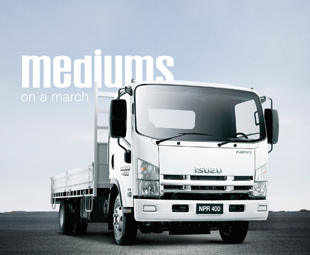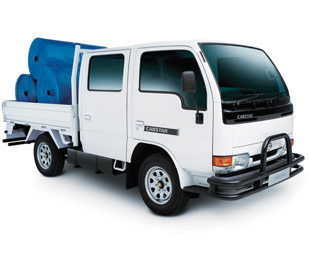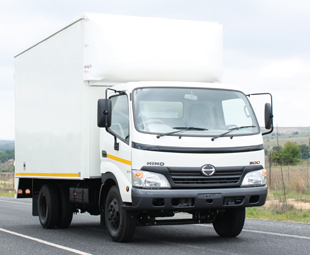Mediums on a march

Despite a threat to its market share position from the extra-heavy segment, the medium commercial vehicle (MCV) sector has stood its ground. FRANK BEETON discusses why.
Medium commercial vehicles (MCVs) are defined by the National Association of Automobile Manufacturers of South Africa (NAAMSA) as those with gross vehicle mass (GVM) ratings falling between 3 501 and 8 500 kg. Operationally, they offer nominal payload capacities of between 1.5 and nearly five tons, fitting neatly between the bakkies of the light commercial vehicle (LCV) category and the heavier 4×2 trucks that make up the heavy commercial vehicle (HCV) segment of between 8 501 and 16 500 kg GVM. The daily range of duties carried out by MCV units is extremely diverse, including city, suburban and rural deliveries of fast moving consumer goods (FMCG); providing support to public utilities and the construction and domestic maintenance sectors; fast freight, commuter and staff transport; truck rental and vehicle recovery. Fleet sizes vary considerably, ranging from “one-man” service providers to huge, nationally-deployed mixed fleets.
 Having officially existed as a discrete market category since 1988, the MCV segment has regularly led the entire local market for vehicles over 3 500 kg GVM. In the first quarter of year 2000, its share of this market peaked at exactly 50% of the total and – although the trend has been gradually downwards since then – MCV’s leadership position only came seriously under threat in 2008, from the premium payload extra heavy category. Over the past 18 months, when lack of credit availability handicapped all commercial vehicle sales and particularly XHCV volumes, these two segments have contested prime position in the market, with the MCV share steadfastly anchored in a range between 30 and 40% market penetration. This indicates the high level of importance attached to this class of vehicle by South African operators.
Having officially existed as a discrete market category since 1988, the MCV segment has regularly led the entire local market for vehicles over 3 500 kg GVM. In the first quarter of year 2000, its share of this market peaked at exactly 50% of the total and – although the trend has been gradually downwards since then – MCV’s leadership position only came seriously under threat in 2008, from the premium payload extra heavy category. Over the past 18 months, when lack of credit availability handicapped all commercial vehicle sales and particularly XHCV volumes, these two segments have contested prime position in the market, with the MCV share steadfastly anchored in a range between 30 and 40% market penetration. This indicates the high level of importance attached to this class of vehicle by South African operators.
Currently, NAAMSA recognises four segments in the MCV market, namely freight carriers, tippers, panel vans, and buses. Unfortunately, the vagaries of the less-than-perfect eNaTIS system allow for the unrecorded after-market conversion of freight carriers into tippers and vans into buses, resulting in a less than accurate statistical breakdown. However, it is possible to determine that the MCV market is divided roughly in the ratio of 55:44 in favour of conventional light truck chassis types over integral panel-van derived models. The latter category, mainly of European origin, has steadily increased its share of the total since its arrival in 1994, while the former – now made up of Japanese- and Indian-sourced units – has experienced consistent growth in absolute numbers of units sold, although it has progressively given up market share.
During the first quarter of 2010, ten manufacturers in the MCV category reported a total of 1 803 sales to NAAMSA. Leading the field as volume supplier was Mercedes-Benz South Africa, with 488 units, achieving 27% penetration. Of these, 389 were variants of the Mercedes-Benz Sprinter integral van family, while the balance of 99 units came from Mitsubishi Fuso’s Canter range of chassis/cab models. Second place overall was occupied by Hino Trucks, with a combination of Toyota-badged Dyna and Hino 300 Series models, all in the chassis/cab category, recording 389 sales for 21.6% penetration. Third place fell to General Motors South Africa or, more correctly, Isuzu Truck South Africa, which supplied 274 of its recently introduced N Series chassis/cab units, to achieve a market share of 15.2 %. Fourth placed supplier was Volkswagen Commercials, with sales of 210 Crafter integral van-based units and 11.6% penetration.
 The balance of the sales, in order of magnitude, was divided between Tata (175 units), Iveco (117 units), Nissan Diesel/UD Trucks (75 units), Peugeot (34 units), Fiat (28 units), and Nissan Motor (13 units). It is noteworthy that, during this period, Nissan Diesel fell well below its 2009 calendar year ranking of fourth best seller in the MCV division, reflecting the run-out of the previous series of UD and Nissan Cabstar-badged vehicles. The new UD 35A, UD40A and UD 40L-A models have just been announced, combining familiar cab and chassis layouts with a 6-cylinder, Euro 2-compliant TD42T six-cylinder engine and new transmission selections. This range will depend on a basic 4×2 configuration, with two wheelbase and two GVM choices, to restore UD’s fortunes in the MCV arena where the brand faces strong competition from its traditional Hino, Isuzu and Mitsubishi Fuso rivals. Isuzu also offers automated transmission, crew cab and all-wheel-drive variants to MCV buyers, while Fuso’s Canter comes in both 4×2 and 4×4 variants.
The balance of the sales, in order of magnitude, was divided between Tata (175 units), Iveco (117 units), Nissan Diesel/UD Trucks (75 units), Peugeot (34 units), Fiat (28 units), and Nissan Motor (13 units). It is noteworthy that, during this period, Nissan Diesel fell well below its 2009 calendar year ranking of fourth best seller in the MCV division, reflecting the run-out of the previous series of UD and Nissan Cabstar-badged vehicles. The new UD 35A, UD40A and UD 40L-A models have just been announced, combining familiar cab and chassis layouts with a 6-cylinder, Euro 2-compliant TD42T six-cylinder engine and new transmission selections. This range will depend on a basic 4×2 configuration, with two wheelbase and two GVM choices, to restore UD’s fortunes in the MCV arena where the brand faces strong competition from its traditional Hino, Isuzu and Mitsubishi Fuso rivals. Isuzu also offers automated transmission, crew cab and all-wheel-drive variants to MCV buyers, while Fuso’s Canter comes in both 4×2 and 4×4 variants.
There is likely to be some accelerated buying of MCV units during the run up to the FIFA World Cup. The versatility, adaptability and affordability of these trucks and vans stand them in good stead to support a host of delivery and venue preparation activities related to this event, and it can be expected that integral vans – which can be placed into operation straight off the showroom floor – will be particularly in demand. Small parties of tourists needing airport-to-hotel or hotel-to-stadium transportation will also create a demand for the type of vehicle that has become popular with our local long-distance taxi community: an integral van locally converted into a midi-bus, or one of the standard MCV bus models now being offered to the market by the likes of Iveco and Tata.
Published by
Focus on Transport
focusmagsa


 !
From 1 Apri
!
From 1 Apri

 Big news from FOCUS on Transport + Logist
Big news from FOCUS on Transport + Logist





 FUSO: Driving the Future of Mobile Healthc
FUSO: Driving the Future of Mobile Healthc



 A brand
A brand




 Wondering about the maximum legal load for a
Wondering about the maximum legal load for a 
 The MAN hTGX powered by a hydrogen combus
The MAN hTGX powered by a hydrogen combus

 Exciting News for South African Operators
Exciting News for South African Operators

